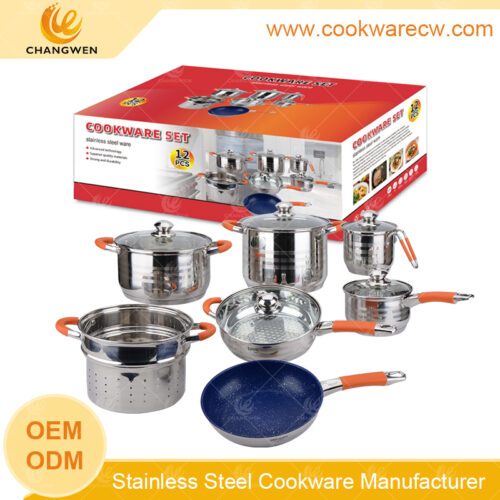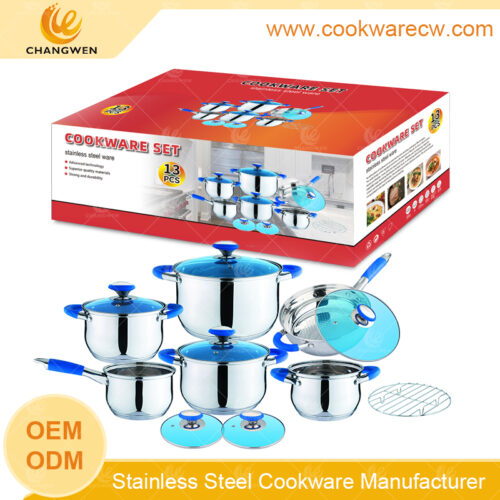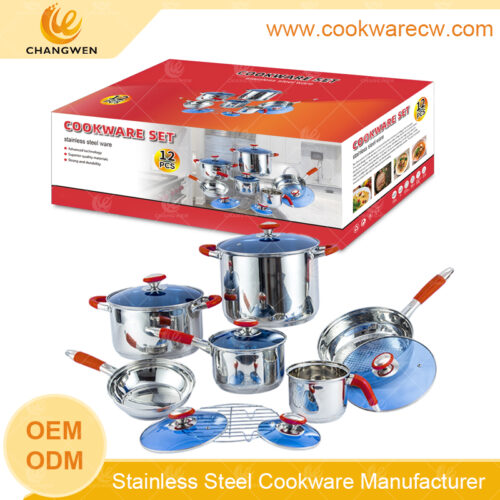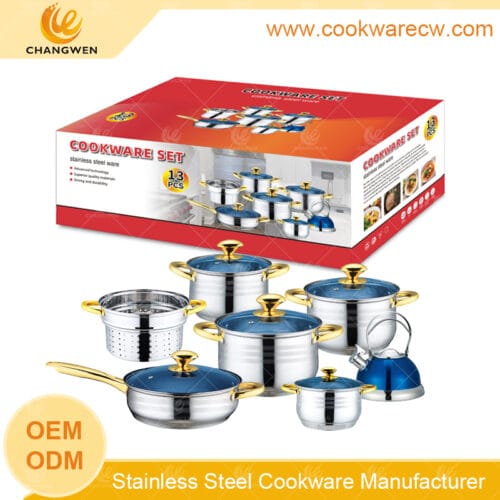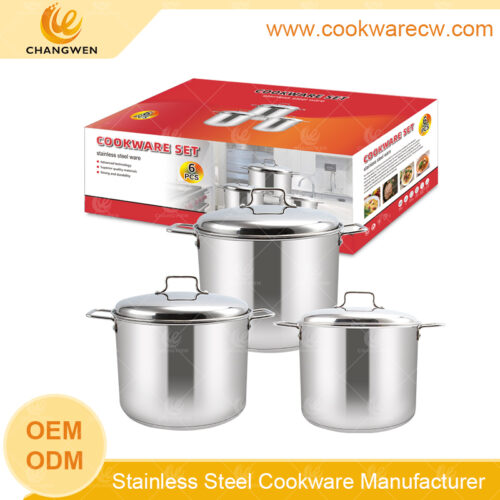Blog
Changwen is a leading cooking utensils manufacturers. We supply high quality stainless steel cooking pots and pans to all over the world. We can also customize the local hot-selling stainless steel pots and pans. Please send your requirements to Changwen.

Milk Pot: A Comprehensive Guide
A milk pot is a small, deep pot with a handle that is often used to heat liquids such as milk, make sauces, or cook small amounts of food. Milk pots are designed to be lightweight, easy to handle, and have good heat conductivity. They come in a variety of sizes, shapes, and materials to suit different cooking needs and preferences.
Features
Milk pots are characterized by their small size, good heat conductivity, and ease of use. They heat liquids quickly and evenly, making them ideal for making hot drinks, sauces, or small meals. Some milk pots also come with additional features such as pouring spouts, scales, or non-stick coatings, further enhancing their functionality and convenience.
Materials
Milk pots can be made from a variety of materials, each with its own advantages and disadvantages.
Stainless steel: Stainless steel milk pots are durable, easy to clean, and resistant to rust and corrosion. They are also suitable for all types of stoves, including induction. However, stainless steel milk pots may take longer to heat up than milk pots made of other materials.
Aluminum: Aluminum milk pots are lightweight, heat up quickly and evenly, and are relatively inexpensive. However, aluminum milk pots may react with acidic foods, causing discoloration or a metallic taste.
Ceramic: Ceramic milk pots are stylish, non-reactive, good at retaining heat, easy to clean, and scratch-resistant. However, ceramic milk pots may be more fragile than other materials and may take longer to heat up.
Non-stick coating: Milk pots with non-stick coatings are easy to clean and prevent food from sticking to the surface. They are ideal for making delicate sauces or foods that are prone to sticking. However, non-stick coatings may wear over time and may release harmful gases if overheated.
Uses
Milk pots are a versatile kitchen tool that can be used in a variety of scenarios.
Heating milk: Milk pots can eliminate bacterial infections in milk while retaining the nutrients in the milk itself.
Making sauces: Milk jugs have good heat conductivity and are easy to use, making them ideal for making small amounts of sauces, gravies, or custards.
Cooking small meals: Milk jugs can be used to cook small amounts of food, such as soups, stews, or pasta. They are especially suitable for single portions or cooking for children.
Melting ingredients: A milk jug can be used to melt butter, chocolate or other ingredients for baking or cooking.
Bean sprouts: Nowadays, many people use milk pots to grow bean sprouts. Put soybeans into a milk pot, add warm water and cover the pot. The small holes on the lid can allow the bean sprouts to ventilate. Change the warm water every morning and evening and then control the water. On the third day, the bean sprouts can be eaten when they have grown to a certain length.
Maintenance Methods
Proper maintenance is essential to ensure the longevity and performance of milk pots.
Cleaning: Milk pots should be cleaned after each use to prevent food residue from building up. Use a soft sponge or cloth and mild detergent to clean the pot. Avoid using abrasive cleaners or scrubbers that may scratch the surface.
Drying: After cleaning, milk pots should be thoroughly dried to prevent moisture from accumulating and causing rust or corrosion.
Storage: Milk pots should be stored in a dry, cool place to prevent moisture or heat damage. They can be stacked or nested to save space.
Market Demand
The demand for milk pots has been steadily increasing in recent years due to their versatility, convenience, and stylish designs. Consumers are looking for kitchen tools that are not only functional but also aesthetically pleasing and easy to use. The rise of small households, single-person households, and the increasing popularity of home cooking have also contributed to the growing demand for milk pots.
What material is the best for a milk pot?
There are many different materials for milk pots, and each material has its own unique advantages and disadvantages. Here are some common milk pot materials and their characteristics:
Stainless steel milk pot:
Advantages: rust-proof, corrosion-resistant, and anti-oxidation, beautiful and durable, not easy to react with acidic foods, uniform heat conduction, and easy to clean.
Disadvantages: When cooking high-starch foods, it may stick to the pot a little, and the heat needs to be controlled.
Glass milk pot:
Advantages: environmentally friendly, not easy to burst, the transparent design allows you to directly see the changes in the boiling milk, high appearance, and very suitable for family use.
Disadvantages: poor thermal conductivity, slow heating speed, and it takes longer to cook food.
Non-stick coated milk pot:
Advantages: suitable for novices or cooking sticky foods, not afraid of sticking to the pot, easy to control the heat, and easy to clean.
Disadvantages: Pay attention to protecting the coating and avoid scratching with sharp kitchen utensils.
Ceramic milk pot:
Advantages: good heat preservation effect, suitable for stewing foods, and can well preserve the deliciousness of food.
Disadvantages: It is heavy, inconvenient to use, and requires maintenance to prevent rust.
How to remove black stains from a burnt milk pot?
Sometimes a milk pot will burn black during use. Here are some effective ways to remove black stains from a milk pot:
White vinegar and baking soda: Mix an appropriate amount of white vinegar and baking soda, heat them, and let the milk pot soak in the solution for a day. This method has a certain effect on some black stains.
Citric acid: Dissolve citric acid in water and heat it, then soak the milk pot for nearly a day. Then gently wipe it with a scouring pad to significantly improve the black marks on the bottom of the pot.
Professional cleaner: Choose a professional stainless steel cleaning product, such as Green Umbrella Wujie Powder or Rabbit Power Stainless Steel Cleaning Paste. Use a damp cloth instead of a steel wool to wipe to avoid scratching the pot surface.
Pot scale wipe clean: For particularly difficult situations, you can consider using pot scale wipe clean. Apply the paste thickly on the bottom of the pot according to the instructions, let it stand for more than 10 hours before cleaning, which can completely remove black stains and restore the brightness of the pot.
Can a milk pot be used for cooking?
Although a milk pot is mainly used for boiling milk, cooking porridge, etc., it can also be used for cooking. However, due to the small area of the milk pot, the heating may be uneven, so special attention should be paid to fire control and ingredient selection when cooking. Here are some suggestions:
Fire control: It is recommended to use medium or low heat to avoid the burning of ingredients due to uneven heating.
Ingredient selection: Choose ingredients suitable for small milk pots, such as green vegetables, tofu, eggs, etc. Try to avoid large amounts of meat or fried food, because the capacity of small milk pots is limited and it is easy to cause overflow.
Preheating and stir-frying: Before putting in the ingredients, preheat the pot to a suitable temperature, add a small amount of oil, and put in the ingredients after the oil is hot. Pay attention to the technique when stir-frying, and try to heat the ingredients evenly.
How to choose a milk pot?
When choosing a milk pot, you can consider the following aspects:
Material: Choose a milk pot made of stainless steel, glass, non-stick coating or ceramic according to your needs.
Handle: Choose a wooden or scald-proof plastic handle with good heat insulation performance, which is safer to use.
Size: Choose the size of the milk pot according to the number of family members and needs. Generally speaking, a 16-18cm milk pot is suitable for a single person or a small family.
Function: Choose a multifunctional milk pot, such as one that can cook noodles, porridge, fry eggs, etc., one pot can be used for multiple purposes, saving kitchen space and purchase costs.
Brand: Choose a well-known brand, the quality and workmanship are more guaranteed.
Conclusion
Milk pots are an essential kitchen tool that has been used for centuries to heat milk, prepare sauces, and cook small portions of food. They are characterized by their compact size, efficient heat distribution, and ease of use. Milk pots can be made from a variety of materials, each with its own advantages and disadvantages. They are versatile kitchen tools that can be used in a variety of scenarios, from heating milk to preparing small meals. Proper maintenance is essential to ensure the longevity and performance of milk pots. With the growing demand for kitchen tools that are both functional and stylish, milk pots are expected to remain a popular and practical choice for many consumers.
Popular Blog
Best Stainless Steel Nonstick Cookware
Which One is Better or best for value,3 Ply or 5 Ply?
How much does a three-layer steamer cost and how to choose one?
What are the purchasing channels for cookware in Mexico?
Choosing the Ideal Material for Woks: Iron or Stainless Steel?
How to clean stainless steel wok
Why choose stainless steel for cookware?
How to open the pot and raise the pot?
What are the materials of kitchen utensils and cookware?
Tags
Recommend Products

12pcs stainless steel cookware set with silicon handles coating conic frypan 24cm pasta pot in China CW-M1311

hot sales cookware supplier 12pcs cooking pots and pans stainless steel cookware set fry pan saucepan coating tea kettle CW-M1223

Wholesale price stainless steel pots and pans mirror polished cookware set saucepan milkpot casseroles with blue silicone and blue glass lids steamer wire rack CW-M1307G-01

Hotsale 12pcs stainless steel cooking set popular pots and pans kitchen soup stock pot with red silicone steamer rack China factory customized color box CW-M1306G-03

Mercado Libre stainless steel 13pcs cookware set tea kettle pasta pot nonstick frying pan golden handle blue coating CW-M1305

China manufacturer stainless steel pots and pans 12pcs cooking set fry pan nonstick set mirror polished cookware 3.0L whistling tea kettle soup stock pot kitchen set steamer rack CW-M1206G

Large Stainless Cook Pot CW-M0607

Customize color box high soup stock pot set stainless steel lids and knobs large volume 10L 13L 15L cookware pots wholesale CW-M0602

